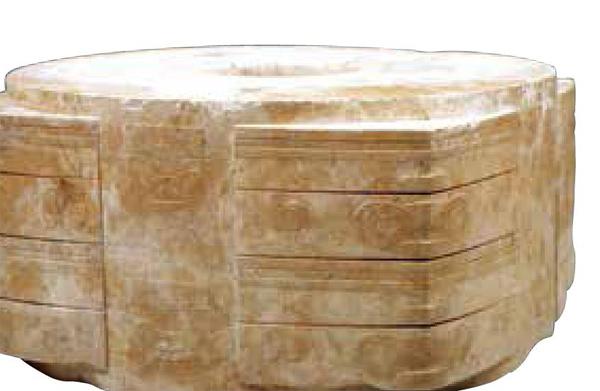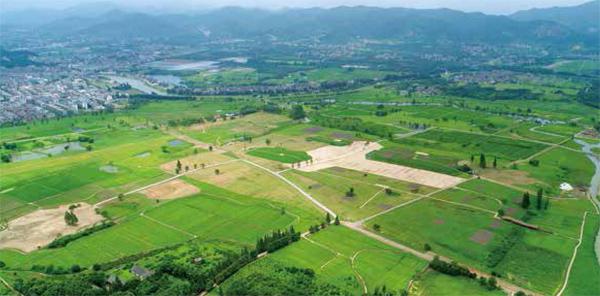从挖出一块石头到发现良渚古城
马黎?杨琳惜
2006年12月20日,在浙江余杭瓶窑葡萄畈遗址发现石头的那个晚上,刘斌睡不着了。他越想这些石头越激动:这一定是个重大发现。
他给自己的老师张忠培先生打电话,又打给北京大学赵辉老师、中国文化遗产研究院的孟宪民先生,第一时间把这个消息报告给他们。
在如今的大莫角山遗址——良渚宫殿区,5000多年前,良渚国王就是在这个小山坡上俯瞰全城。他不会想到,5000年后,一位儒雅的西北男人及其考古队,通过泥土里不起眼的石头,发现了自己的国家。
30多年前,刘斌来到杭州工作,之前他只知道杭州有个著名的遗址叫良渚,却不曾想自己与这块土地的缘分,一结就是30多年,至今仍在继续。
从1986年在瓶窑反山发掘王陵墓地开始,良渚遗址考古的重大发现,刘斌一一见证:良渚遗址至今已6次入选全国十大考古发现,2008年底开始对古城内外进行大范围勘探,至今已完成近20平方公里范围的摸底工作。从发现近3平方公里的内城,到发现6.3平方公里的外城,再到发现良渚古城外围大型水利系统——10年的探索,换来了今天世界考古学界对良渚王国的认可,对中华5000年文明的认可。
历史的一大步,有时其实是从考古人的一小铲甚至是从一块小石头开始的。然而,如果没有像石头一般的执着和硬气,我们何曾知道,5000年其实离我们并不远。
(一)
2006年12月,刘斌带着考古队在瓶窑葡萄畈遗址进行试掘。一条良渚时期的南北向古河道的发现,让刘斌感觉有戏。洛阳铲一铲下去,在3米多深的地方,碰到了石块。
如果要说良渚古城发现的瞬间,这72个字似乎就可以说完了——对,不是玉器,也不是陶器,只是一层石块,没有任何惊心动魄的戏剧性场景,谁都不会想到发现的是一个古城,一个国家。
刘斌没有放过这一层石块,困惑,纠结,论证,始终在继续。
他的老师,著名考古学家张忠培先生说的话,刘斌一直印在心里:被材料牵着鼻子走。
“你发现了石块,然后怎么办?怎么样去理解材料,这些材料带给你的信息是什么?”
有些人会觉得,一堆烂石块而已,也不是什么宝贝。但刘斌觉得,这些东西带来的思考、困惑,就是重要材料,他必须思考每一个点、每一寸土背后的秘密。
他开始“破案”——石块是在3米多厚的黄土堆积的下面发现的,而且中间没有间隔,是一次性堆上来的,说明这些石块应该是3米多厚的土的一个基础,很有可能是大堤或者城墙。他再看石块,发现是开采来的,那么,是从哪个山上开采来的?城墙的堆土,是山上的黄土,他就想到,现代修大堤,也是从山上运过来的,那必定是一个大工程。
“所谓的‘被材料牵着鼻子走,当某一种材料能触动你,就要把它搞明白,要被它牵着走,找出它有多长有多宽,再顺此想下去,这个石块是从哪儿来的,后面的科技设计都是从这个角度来做的。考古就是教我们怎么样去追寻遗迹,怎么样去发现它的功能。”刘斌说。
(二)
2007年,刘斌和良渚考古队依次发现了西城墙、北城墙、东城墙。当11月最终发现南城墙时,这座被历史的泥沙淹没了5000年的王城,就真的出现在了我们的脚下。
“5000千年并不遥远,穿过那间宋代酒肆的残垣断壁,从汉代人的墓地经过,我们便可望见5000千年前的篝火……”
2016年冬天,在反山王陵南面姜家山发现新墓地时,爱写诗的他,伏在良渚工作站的书桌前,写下这些浪漫的句子,与良渚人隔空相望。
很多人说,刘斌这个人比较理想主义,爱较劲,如果不是他的坚持,或许这层石块,就只是石块了。
但是,当一个重大发现摆在眼前时,他反而觉出了一种孤独。
古城发现后,来自各方的质疑声不断涌来,一路上,刘斌遇到了很多红灯。他一个人带着几个技工,请来各种专家,开论证会,寻求学术支持,包括向国家申请研究经费,征地,和村里人打交道,努力保护遗址范围。
考古不只是考古,考古人有时候像个包工头,有时候还像居委会的工作人员,大量的生活琐碎,鸡毛蒜皮,他们全都要應对和解决——跟施工队磨合工期,动老百姓的田地又涉及青苗补偿,雇佣民工、管理民工都需要妥善安排,而考古队本身也有一摊吃喝拉撒的事。
良渚已经成为中国第一批(12家)国家考古遗址公园之一,目前一期正在建设中。在遗址公园的修建过程中,这棵树该不该砍,那条路该不该修,觉得哪里不对,不少细枝末节刘斌全都要管。看到有人往遗址里乱倒垃圾,他直接去挡车。在这个斯文的男人的心中,藏着十头牛也拉不动的较劲和执着。
有一段时间,莫角山遗址北边的村子拆了,房子下面的垃圾没有运干净,上面铺了土,变成了农田,边上修起了石坎。刘斌又激动了:修那么多生硬的东西做什么,把垃圾运走,原来底下就是田,现在还造田,不就是弄虚作假吗?做石坎那么生硬,遗址就难看了,就毁了。
“我确实给他们的工程造成了很大的麻烦。”他笑道,“但把遗址毁了,我就要管。”
“经常有人问我,考古苦不苦。这是个傻傻的问题。人生在世苦不苦?谁又能为我们开释得比佛陀更清楚。考古是一场修行。面对历史,我们不能改变什么、发明什么,只能在坚定的信念里,走近历史的真实。”刘斌说。
对话从上大学到现在的笔记、老照片,都是我一直珍藏的,但对我来说最具有纪念意义的是一个棕榈箱子,里面是木头,外面包裹着棕片。这是1981年我上大学前,在西安老家买的。那个时候没有皮箱,就用这只箱子装被子、装衣服、装书,托运到杭州。后来在杭州工作那么多年,搬了几次家,也一直舍不得丢,用到现在。
仔細,有条理。考古工作类似于做档案、做记录,比如在野外挖掘,需要每天写日记、整理资料,这就要求有很好的条理性,资料的记录不能杂乱无章。
喝茶、静坐。我也爱好文学,爱看书,喜欢诗歌。近些年看得比较多的是有关于宗教、茶文化、中医的书,还有这几年流行的灵性与科学方面的书。总的来说,我读的书大多围绕着对宇宙、对人生的思考感悟,比较偏向哲学意义的探讨。
改革开放最大的感受,就是日新月异的变化。首先是一种时间加速感,人与环境的变化,各种变迁非常迅速,这是信息时代带给我们的。考古是了解过去,从懵懵懂懂认识器物开始,再到社会发展基本模式,再到大的历史变迁,人的流动,环境的变迁,从宏大的时空中探寻变化的过程。
改革开放40年,对从事考古来说是幸运的。以前我们的状态是封闭的,对外界不了解,但现在我们能够走出国门,有了网络媒介,信息知识的流通更加频繁,我们不仅能了解过去,还能知道整个世界的历史文化,观察、体验各个地区不同环境所造成的文化差异。
Liu Bin: Archaeologist Who Finds Ancient City
By Ma Li, Yang Linxi
Liu Bin was sleepless on a December night in 2006. That day, he had stumbled upon a layer of stones three meters underground at a site in Putaofan, where an archaeological investigation was undergoing. The site is part of the Liangzhu Culture, which was first discovered in the 1930s and named in the 1950s. Archaeological work has been going on for decades.
That day, he and his colleagues were exploring a north-south ancient river in Putaofan when the Luoyang shovel in his hands went down and he felt the shovel touch stones at a depth of 3 meters. These were neither jades nor potteries. Liu was excited. The stones were apparently from a quarry. The earth as thick as 3 meters was artificially heaped upon the layer of stones. What was underneath was probably a dike or a section of a city wall. He tentatively concluded that it must have been a colossal undertaking back then. Excited and certain that the stones pointed to something important, Liu made a few phone calls.
Liu Bin came to Hangzhou more than 30 years ago. His life has been closely connected with Liangzhu. He has witnessed all the key breakthroughs made in the archaeological work on the Liangzhu Culture. Liangzhu has been named six times on the annual top ten of national archaeological discoveries.
In 1986, archaeologists found the royal mausoleums at Fanshan. The stones discovered in December 2006 opened u a new possibility, though many people were skeptical about the significance of the stones. Liu invited experts and specialists over to take a look. He was instrumental in holding some seminars to find academic support. He applied for national funds for further excavation and for safeguarding of the site.
Eventually, funds came in and the green light was given. The efforts quickened.
In 2007, Liu Bin and his colleagues found the city walls in the west, in the north, in the east and in the south in that order. In 2008, archaeologists intensified their search. Since then, key discoveries have been made. They first found the 3-km2 inner city, then the 6.3-km2 outer city, and then a large-scale extensive water-control system on the peripheries of the state. These discoveries made within the last ten years have convinced the world that an early state did exist in ancient Liangzhu and that the Chinese civilization is at least 5,000 years old.

In reality, Liu Bin is more than an archaeologist. In order to keep the sites intact in Liangzhu, he has done a lot. He is a care taker of these archaeologists. He negotiated with the neighboring villages for the safeguarding. He stopped numerous activities, including some development projects which could have damaged the sites.
“Some people ask me if I feel archaeological work too hard. It is a silly question. Isnt life hard, too? Who can explain life better than Buddha does? Being an archaeologist is improving oneself toward perfection. We can neither change history nor invent history. All we can do is to continue to believe and approach the truth of history,” remarked Liu Bin.
Liu Bin is director of Zhejiang Institute of Cultural Relics and Archaeology. He has published over 60 academic papers. His insightful analyses convincingly explain how some jade pieces of the Liangzhu Culture evolved in ancient times. Right now he heads a national project on the study of civilization modes in the lower reaches of the Yangtze River, a project going on in relevant provinces sponsored by the National Administration of Cultural Relics, the top national authority on archaeology. He also heads the archaeological project on the ancient Liangzhu city, a key national undertaking. Under his leadership, the archaeological field studies around Liangzhu have received annual top national awards several times.

